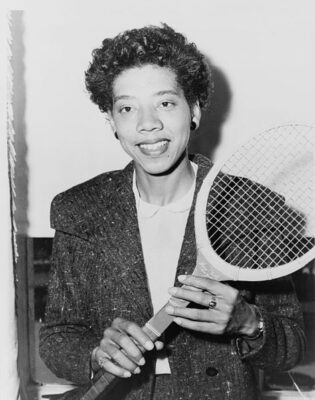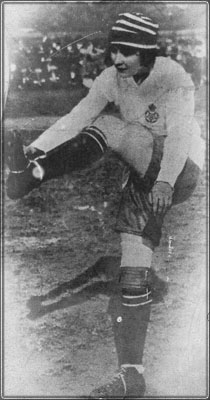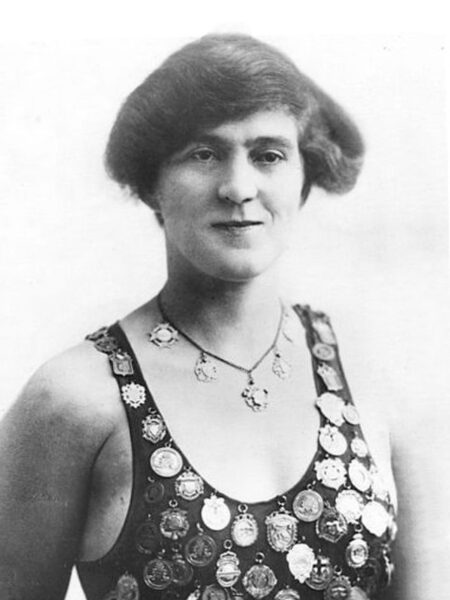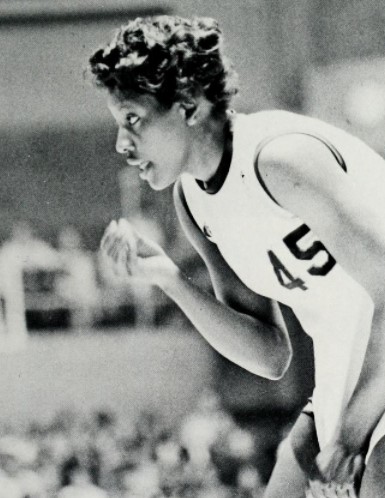The problems women in sporting history faced weren’t limited to underrepresentation or being undervalued. It was that, despite being as good, if not better, than their male counterparts, the majority were rarely given the same opportunities. So, it wasn’t until years, sometimes decades, after the sport was invented that they were even able to participate in it. Let alone be appreciated for their talent.
Society often blames women’s absence from sport on a lack of desire to participate or a lack of skill. Not to mention that ‘women were too delicate to compete in contact sports.’ The truth, however, is that women were never given the same chance to prove that they were great athletes. Pushed down and cast aside, women had to pave their own way into the world of sport.
And that’s exactly what these women did…
Tennis
The sky was the limit for 16-year-old Maureen Connolly. In 1953, she become not only the youngest, but the first woman to score a Grand Slam. This means she won all four major world tennis titles in a single season.
Nearly a century before her, a woman named Mary Ewing Outerbridge single-handedly bought tennis equipment from Bermuda and used it to set up the first tennis court in Staten Island. Mary not only introduced tennis to the richest borough of New York, but she also introduced tennis to the entirety of the United States. She was later dubbed by historians ‘The Mother of American Tennis’.
In 1956, Althea Gibson, the top-ranked female tennis player in the world, achieved great success. She shattered barriers not only as a female tennis player, but as a black female tennis player. She became the first African American person to play in a major US Lawn Tennis Association event, to compete and win at Wimbledon. Not only that, but she went on to win 11 grand slam titles (5 singles, 5 doubles, 1 mixed). This earned herself a well-deserved place in the ‘International Women’s Sports Hall of Fame’.
Fast-forward to the 21st century, and Naomi Osaka, 4 time Grand Slam champion and the first Asian player to be ranked No.1 in singles, has not only excelled on the court. She has also become a global voice for mental health, racial justice, and athlete activism. Her refusal to ‘just play the game’ echoes Gibson’s legacy.
 Althea Gibson
Althea Gibson
Football
Women’s football is slowly coming to the forefront, but just because it’s only now beginning to be appreciated doesn’t mean it hasn’t been around for a long time. In fact, it has been played in England for over a century!
The first international women’s football match between England and France took place in 1920. It featured a player by the name of Lily Parr. Parr began playing football professionally at the age of 14. Surprisingly, women competed against both men and women at this time. Parr certainly held her own against both genders. Across her 32-year-long career, she racked up over 980 goals! What is most staggering is that she did that all whilst working as a nurse in a psychiatric hospital. Lily has since been honoured for her contribution to women’s football. In 2019, she became the first female football player to be commemorated with a statue at the National Football Museum.
Fast Forward to today, and the women’s game has exploded in popularity. In 2023, the FIFA Women’s World Cup saw record-breaking attendance and viewership, with over 2 billion viewers globally. Players like Alexia Putellas of Spain – the first women to win back-to-back Ballon d’Or Féminin awards (2021, 2022) – and Sam Kerr of Australia – the country’s all-time leading goal scorer – are redefining what it means to be global football stars.
 Lily Parr
Lily Parr
International Stars
Becoming the youngest to achieve a milestone should be regarded as a monumental accomplishment. Such an accomplishment can be accredited to Birgit Prinz, a German female footballer who is the youngest player to appear in a World Cup Final. Her success hardly stopped there. In 2003, she was offered a contract with the men’s Serie A side Perugia, one of the most prestigious football clubs in Umbria, Italy. Prinz, however, rejected the offer — and rightfully so. Fearing that she would be used just to attract the media’s attention, Prinz refused to become a publicity stunt. Instead, she became an active advocate for equality and equity for women in football.
Continuing with the record-holding football players is Marta Vieira da Silva. She holds the record for most goals in any FIFA World Cup (17 goals), men’s or women’s. Marta also became the first footballer ever to score in five consecutive World Cup tournaments. Her achievements aren’t just significant for women’s football: they have changed the game as a whole.
At the 2024 Olympics, Barbra Banda of Zambia became the first woman to score back-to-back hat tricks in Olympic history, proving that excellence in football isn’t confined to powerhouse nations.
Behind the lines
Women aren’t only thriving on the pitch; they are excelling behind the scenes just as much. Former footballer and current coach Hope Powell is the first woman to hold a UEFA Pro License. This is is the highest qualification available to any manager. She coached the women’s national football team and Great Britain’s women’s team at several Olympics. In doing so, she became not only the first female, but the first person of colour to manage England at any level.
In 2021, Bev Prietman led Canada to their first-ever Olympic gold in women’s football as head coach. Her tactical leadership proved that women are equally capable in high-performance management roles.
Swimming
At the age of 14, Hungarian swimmer Krisztina Egerszegi became the youngest female Olympic champion in history, winning the 200-meter backstroke in 1988. When people say age is just a number, this is what we all should assume is being talked about. Not only did she snatch the gold, but she also set a world record! The record stood for more than 17 years.
Another Olympic pioneer in swimming is athlete Fanny Durack. During the 1912 Olympics in Stockholm, she became the first female champion in the history of the games. She set a record in the 100-meter freestyle, winning the gold. During the peak of her career, between the years of 1910 and 1018, Durack held every record in women’s swimming. The 100-meter freestyle to the mile. To put it into perspective, nowadays such a milestone is not only unheard of, but it is an impossible achievement that very few have tried to accomplish. The ones that have, ultimately failed.
In 1926, with a time of 14 hours and 34 minutes, Gertrude Ederle became the first woman to successfully swim across the English Channel. This was a huge step for women’s marathon swimming, for her time was 2 hours faster than the top men’s time at that time!
In more recent history, Katie Ledecky of the U.S. has dominated long-distance freestyle events, becoming the most decorated female swimmer in World Championships history. As of 2024, she had won 21 gold medals.
 Fanny Durack
Fanny Durack
Basketball
When basketball was invented in 1891 by Dr. James Naismith, no one really thought of teaching the sport to women. But a couple of years later, two women, Senda Berenson and Clara Gregory Bear, took the matter into their own hands. They introduced basketball to young girls for their P.E classes, turning the game into the first ever women’s team sport. The rules, however, had to be modified due to the Victorian medical misconceptions that women are fragile and are prone to suffer from ‘nervous fatigue’. Only decades later, in the beginning of the 20th century were women ‘allowed’ to play basketball in the original way it was created.
Since its creation to modern day basketball has gone through many changes. It has been influenced by countless people and shaped into the game that is loved by millions today.
Queens of the Court
Historically, one of the most influential people for the game is none other than Sheryl Swoopes. For a long time, her name was synonymous for the league. She was a trendsetter, setting the mark for everyone else playing the game. She became the first to record a triple-double, and the first to win an NCAA championship, a WNBA title and an Olympic gold medal. When people thought of WNBA, they thought of Sheryl Swoopes. She was the first player in both WNBA and NBA history to win 3 MVP’s and 3 DPOY awards. She is truly one of a kind.
Swoopes’ predecessor and most likely inspiration was Lusia Harris. Harris is credited as the first and only woman ever officially drafted by the National Basketball Association (NBA), a men’s professional basketball league. The WNBA was yet to exist. However although she was picked over 33 male candidates Harris never actually played for the NBA. It later transpired that she turned down the offer due to her pregnancy. However that doesn’t take away from her achievements. She was MVP multiple times throughout her college career, won a gold medal at the Pan American games, and scored the first ever points in a women’s Olympic basketball tournament. As if that wasn’t enough she even has an academy nominated film – aptly titled The Queen of Basketball .
The modern game belongs to stars like A’ja Wilson, Breanna Stewart, and Sabrina Ionescu, whose three-point shooting contest against Steph Curry at the 2024 NBA All-Star Weekend went viral – symbolising a shift in how seriously women’s basketball is now taken.
 Lusia Harris
Lusia Harris
Gymnastics & Beyond
No update on women’s sport would be complete without Simone Biles. With 37 Olympic and World Championship medals, Biles is the most decorated gymnast of all time. Her withdrawal from the 2020 Tokyo Games to prioritise mental health launched a global conversation and reset expectations for athlete wellness and agency.
Closing Thoughts
These women have changed their retrospective games, and pioneered their sports. The legacies they’ve left behind continue to inspire rising young athletes, who in turn will inspire the next generation. For as long as they have been allowed to participate, women have broken barriers in the sporting world. And thanks to those who came before them, they can continue to do so, continuing to pave the path towards true equality.
